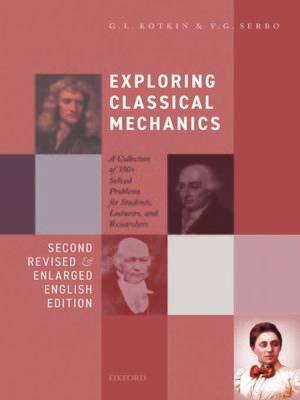Exploring Classical Mechanics
ebook ∣ A Collection of 350+ Solved Problems for Students, Lecturers, and Researchers--Second Revised and Enlarged English Edition
By G. L. Kotkin

Sign up to save your library
With an OverDrive account, you can save your favorite libraries for at-a-glance information about availability. Find out more about OverDrive accounts.
Find this title in Libby, the library reading app by OverDrive.



Search for a digital library with this title
Title found at these libraries:
| Loading... |
This new edition of a popular textbook offers an original collection of problems in analytical mechanics. Analytical mechanics is the first chapter in the study and understanding of theoretical physics. Its methods and ideas are crucially important, as they form the basis of all other branches of theoretical physics, including quantum mechanics, statistical physics, and field theory. Such concepts as the Lagrangian and Hamiltonian formalisms, normal oscillations, adiabatic invariants, Liouville theorem, and canonical transformations lay the foundation, without which any further in-depth study of theoretical physics is impossible. Wherever possible, the authors draw analogies and comparisons with similar processes in electrodynamics, quantum mechanics, or statistical mechanics while presenting the solutions to the problems. The book is based on the authors' many years of experience delivering lectures and seminars at the Department of Physics at Novosibirsk State University — totalling an impressive 110+ years of combined teaching experience. Most of the problems are original, and will be useful not only for those studying mechanics, but also for those who teach it. The content of the book corresponds to and roughly follows the mechanics course in the well-known textbooks by Landau and Lifshitz, Goldstein, or ter Haar. The Collection... starts with the Newtonian equations, motion in a central field, and scattering. Then the text proceeds to the established, traditional sections of analytical mechanics as part of the course on theoretical physics: the Lagrangian equations, the Noether theorem, linear and nonlinear oscillations, Hamilton formalism, and motion of a solid body. As a rule, the solution of a problem is not complete by just obtaining the required formulae. It's necessary to analyse the result. This can be an interesting process of discovery for the student and is by no means a "mechanical'' part of the solution. It is also very useful to investigate what happens if the conditions of the problem are varied. With this in mind, the authors offer suggestions of further problems at the end of several solutions. First published in 1969 in Russian, this text has become widely used in classrooms around the world. It has been translated into several languages, and has seen multiple editions in various languages.






